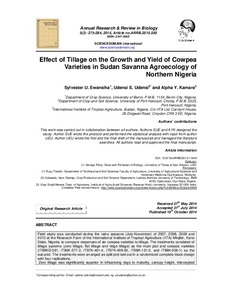| dc.contributor.author | Ewansiha, S.U. |
| dc.contributor.author | Udensi, U.E. |
| dc.contributor.author | Kamara, A. |
| dc.date.accessioned | 2019-12-04T10:58:16Z |
| dc.date.available | 2019-12-04T10:58:16Z |
| dc.date.issued | 2014-10-10 |
| dc.identifier.citation | Ewansiha, S.U., Udensi, U.E. & Kamara, A. (2014). Effect of tillage on the growth and yield of cowpea varieties in Sudan savanna agroecology of Northern Nigeria. Annual Research & Review in Biology, 5(3), 275-284. |
| dc.identifier.issn | 2347-565X |
| dc.identifier.uri | https://hdl.handle.net/20.500.12478/955 |
| dc.description.abstract | Field study was conducted during the rainy seasons (July-November) of 2007, 2008, 2009 and 2010 at the Research Farm of the International Institute of Tropical Agriculture (IITA) Minjibir, Kano State, Nigeria; to compare responses of six cowpea varieties to tillage. The treatments consisted of tillage systems (zero tillage, flat tillage and ridge tillage) as the main plot and cowpea varieties (IT89KD-391, IT90K-277-2, IT97K-461-4, IT97K-499-35, IT98K-131-2, and IT98K-506-1) as the sub-plot. The treatments were arranged as split plot laid out in a randomized complete block design with four replications.
Zero tillage was significantly superior in influencing days to maturity, canopy height, intercepted photosynthetic active radiation (IPAR) and leaf area index but not total dry matter and grain yield of cowpea. A positive and significant association was recorded for days to physiological maturity and canopy height across the tillage systems with a correlation coefficient of ≤ 40% for days to maturity and ≥50% for canopy height. Though flat tillage showed a positive correlation with intercepted photosynthetic active radiation (IPAR) and leaf area (LAI), but this association was not significant. However, ridge tillage showed a positive and significant correlation with IPAR and LAI (r =0.378*** and 0.384***). All the tillage systems showed a high and significant positive correlation with cowpea dry matter and fodder yield (r= 0.54*** to 0.77***). Across varieties, grain yield was better with flat tillage than zero and ridge tillage systems, with 10% yield advantage over the two. Zero and ridge tillage were similar in their effects on grain yield. Except for IPAR, LAI and total dry matter (TDM), the interaction effect of cowpea varieties and tillage systems was significant. Our result point to the fact that extensive soil tillage (especially, conventional tillage) may not be necessary for cowpea production in this agro-ecology with a high percentage of sand and a sandy loam as soil textural class. Following our result, we may recommended varieties for the different tillage systems as follows: IT98K-131-2, IT97K-461-4, IT90K-277-2, IT98K-506-1 (grain) and IT89KD-391/IT97K-461-4 (best for fodder) for zero tillage system; IT90K-277-2, IT97K-499-35, IT98K-131-2 and IT98K-506-1(grain) and IT89KD-391/IT97K-499-35 (best for fodder) for flat-tillage; IT98K-131-2, IT90K-277-2, IT98K-506-1 and IT97K-464-4(grain) and IT90K-277-2/ IT89KD-391 (best for fodder) for ridge tillage) |
| dc.format.extent | 275-284 |
| dc.language.iso | en |
| dc.subject | Fodder |
| dc.subject | Cowpeas |
| dc.title | Effect of tillage on the growth and yield of cowpea varieties in Sudan savanna agroecology of Northern Nigeria |
| dc.type | Journal Article |
| dc.description.version | Peer Review |
| cg.contributor.crp | Grain Legumes |
| cg.contributor.affiliation | Université du Bénin |
| cg.contributor.affiliation | University of Port Harcourt |
| cg.contributor.affiliation | International Institute of Tropical Agriculture |
| cg.coverage.region | Africa |
| cg.coverage.region | West Africa |
| cg.coverage.country | Nigeria |
| cg.authorship.types | CGIAR and developing country institute |
| cg.iitasubject | Cowpea |
| cg.iitasubject | Grain Legumes |
| cg.journal | Annual Research & Review in Biology |
| cg.howpublished | Formally Published |
| cg.accessibilitystatus | Open Access |
| local.dspaceid | 77575 |
| cg.targetaudience | Scientists |
| cg.identifier.doi | https://dx.doi.org/10.9734/ARRB/2015/11649 |

